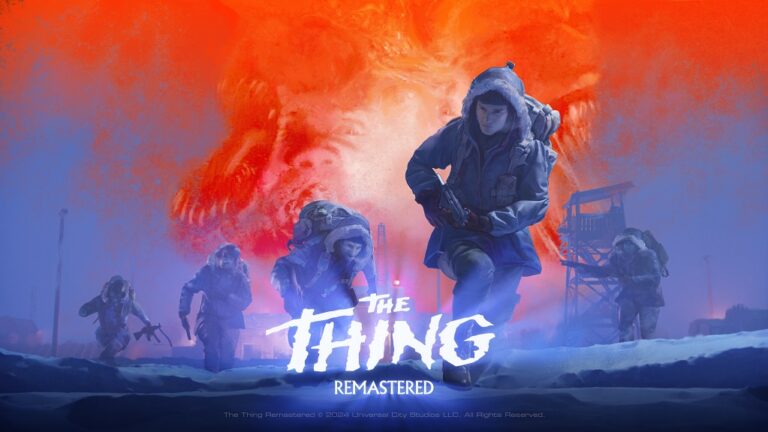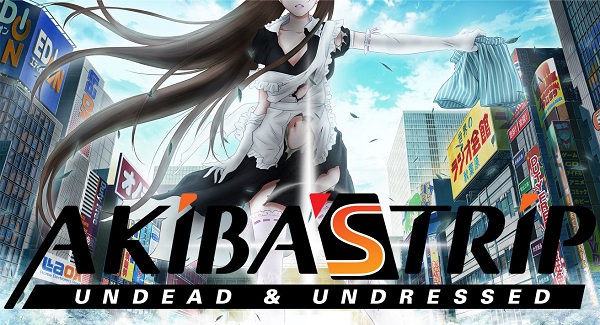
Akiba’s Trip first came to my attention about a year ago when I saw an import copy in my local game store. I was tempted to pick it up for review purposes, but my procrastination rewarded me as XSEED eventually announced that they would be localizing the game for English speakers.
It’s hard not to feel a bit awkward explaining Akiba’s Trip to someone that has not yet looked into the game for themselves. Thought to be a hentai (or even molestation) game by onlookers, Akiba’s Trip is merely a goofy game in which the primary means of combat involves stripping the clothes off of vampiric foes to expose them to purifying sunlight. With that said, Akiba’s Trip‘s niche factor may deter some people, but I had quite a good time with it.
One of the main draws of Akiba’s Trip: Undead & Undressed is the fact that it takes place in Akihabara, Tokyo’s nerdy little shopping district. From its streets, buildings, storefronts, and even store interiors, Akihabara has been recreated as a virtual playground and is a focal point in the game’s story.
Akiba’s Trip is a game that centers around the otaku/geek culture of Japan. The game parodies many tropes and cliches found within otaku communities, Japanese games, and anime. If you’re not familiar with these kind of nods, some references and punchlines may go above your head, but there’s a genuinely appreciable amount of humor found in the game despite its niche focus.
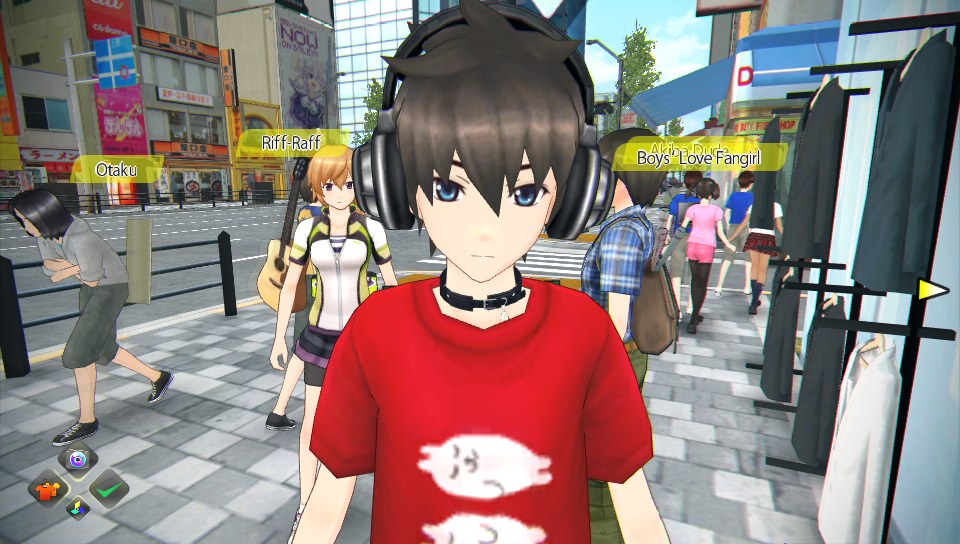
Our hero, Nanashi (or whatever you choose to rename him as) awakes in a dungeon after a faux job interview with a group simply known as The Organization. Nanashi quickly discovers that he’s slowly being turned into a Synthister, a vampire-like drone for The Organization’s nefarious scheme. Upon being saved by a mysterious girl named Shizuku, Nanashi enters a blood pact with her in order to retain his consciousness, but at the cost of his humanity. This change allows him to become stronger than the average human, but also susceptible to the damaging effects of sunlight.
The narrative of Akiba’s Trip is led by dialogue choices on behalf of the player. As Nanashi, you can either use your newfound power to become a righteous hero, a loner, a perverted, selfish asshole, or something in between. The way characters respond to your comments will of course differ, and the game’s endings are based on your actions with them, especially the members of Nanashi’s team.
The story of the game isn’t anything spectacular, and perhaps relies too heavily on spoofing the formulaic teens save the world cliché. Regardless, there’s a lot of humor to be found in the game, and the story merely provides a decent reason to work on the campaign. The cast of characters are also nothing to write home about, but there’s more than enough fun exchanges between them to foster favorites. An in-game email account and social network also provides some good laughs in between missions.
Missions in Akiba’s Trip can be a tad repetitive in the way that you complete them (most of the time being through fighting a person or group), but some are downright hilarious. Side missions, which appear in between story missions, create ridiculous scenarios that Nanashi has to endure and resolve. Whether it’s a fanatical boy’s love fan preaching her passions to pedestrians; a group of art dealers that hustle people for cash; a crazed otaku deep into roleplay; or disbanding a group of catcalling thugs by cross-dressing and then beating them up.
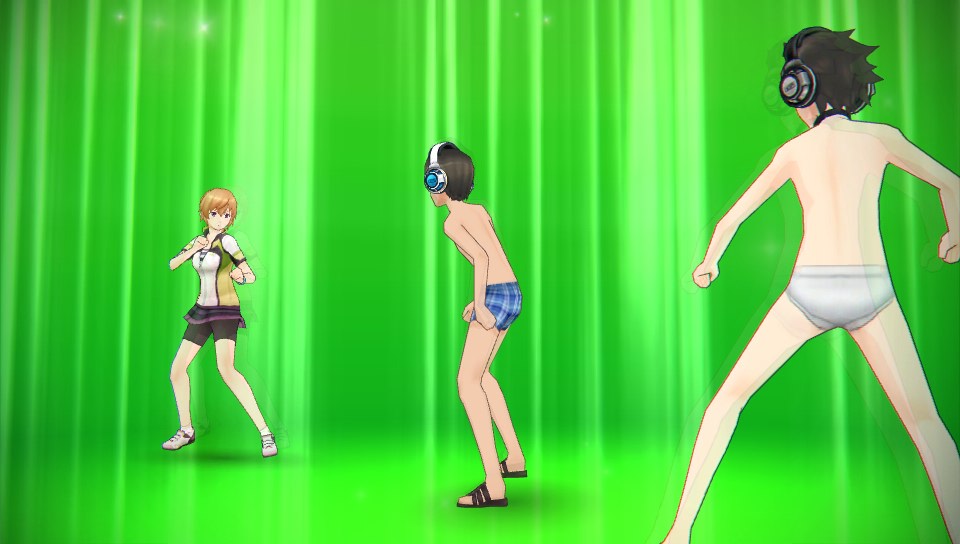
In this game you will be taking off a lot of people’s clothes. Combat in Akiba’s Trip relies on three attack buttons, blocking, countering, and strip finishers. Enemies in the game must be defeated by attacking their clothing, zoned by the head, chest, and legs. Delivering enough damage to one of these zones will show visible damage as a sign that the clothing item can be removed. As Nanashi, it’s the player’s job to break down the enemies defense enough that each clothing item that they have in their possession (minus their shoes) can be ripped off, which will either lead to their death if they’re a Synthister or simple embarrassment.
Nanashi’s three attacks can be mixed together to perform combos that strike multiple parts of an enemy. Stylish finisher moves can be performed on a group of enemies granted a substantial stripping-combo chain is made, resulting in a takedown that removes the underwear (censored by a white light) from defeated foes. The remaining lot become dazed and susceptible to further attacks.
While being simple, there’s a genuine level of enjoyment to be found in Akiba’s Trip‘s combat system. Getting into a large fight can be challenging, with the game putting a strong emphasis on patiently waiting for counter attack openings and not button mashing. Some strip finishers (which are unlocked at a local dojo) add a lot of humor and satisfaction to taking down an enemy. One downside, though, is the game’s lack of a combat camera that automatically updates its orientation. You’ll occasionally end up in situations where either Nanashi or his targets are obstructed by an object in the map, and manually adjusting the camera opens up the possibility of being attacked.
As for weapons, Nanashi can employ the use of a wide variety of types, ranging from toys, food items and props, to computer parts. Think Dead Rising in the level of absurdity of what constitutes as a weapon. Weapons and clothing are assigned values that represent their level of damage and defense, respectively. Nanashi’s younger sister, which offers up a satirical take on the whole imouto anime archetype, can combine items together to improve their stats. Additionally, clothing, weapons, boosters, and other items can be purchased from the surplus of stores across Akiba’s many districts.
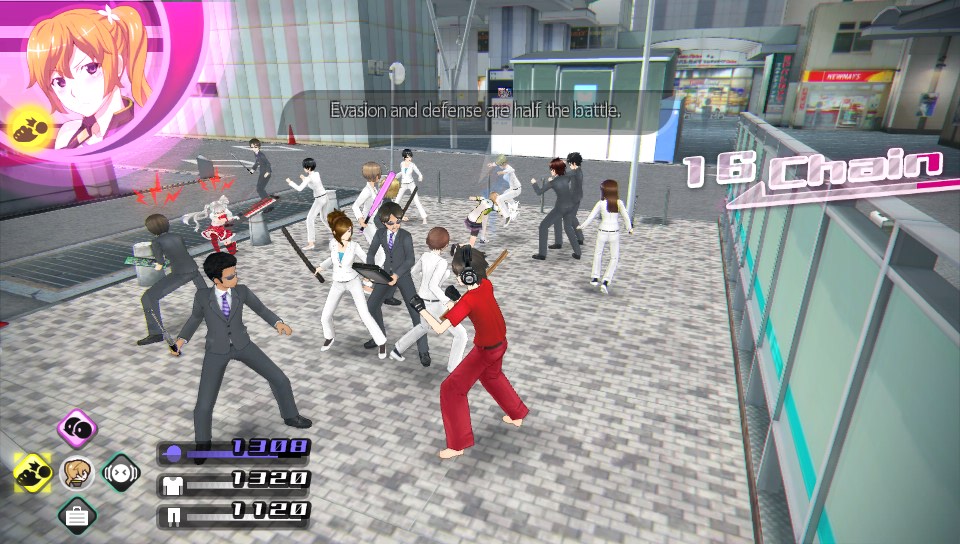
Akiba’s Trip is an open world game in a sense. The game’s map is not all too large, but still visually interesting. Perhaps my biggest complaint with the game is that each area is separated by a loading screen, effectively making exploration a tedious task. Some areas are rather small, exacerbating this problem. It’s a bit perplexing why the game’s map couldn’t work as a traditional open world title with full exploration and very little loading when other games manage to do so.
Playing Akiba’s Trip on the Vita offers up its own pros and cons. The game’s anime-styled visuals really pop on the Vita’s screen, but technical limitations seems to have burdened the development team. With the hassle of the amount of loading screens also comes an issue pertaining to NPC draw distance. Upon loading a zone, it takes at least 10 seconds or so for NPCs to appear in the map. The distance in which NPCs can be seen is also rather low, making missions where you have to find a specific character a bit of a burden.
Distinctly noticeable framerate drop also plagues battles – the larger, the worse it can be. While the lag doesn’t hurt combat too much in terms of mechanics and effectiveness, the animations suffer. Had lag not hampered these scenes, combat would have been visually more enjoyable.
Akiba’s Trip‘s weapon and clothing system may attribute stats to different items, but don’t expect an in-depth system. For example, some weapons will always be useless, regardless of what level you unlock them as, and some clothing choices will always be better than others. Nanashi’s sister can boost the stats of any item that you want, but the game seems to lack an expected amount of depth in this department. I’m sure many will fall back on the highest tier items that they find rather than going the unnecessary route of upgrading something they enjoy the appearance of.
It’s also worth mentioning that Akiba’s Trip has dual audio, allowing for players to choose whether they want to experience the game in Japanese or English; it’s as easy as going to the main menu and changing the language options. I was quite surprised by the quality of the English VO. I have seen some concerns over the tonal changes for some characters, like Nana, Nanashi’s sister, but I actually liked her English performance. The English cast does a fine job, which was something I didn’t expect.
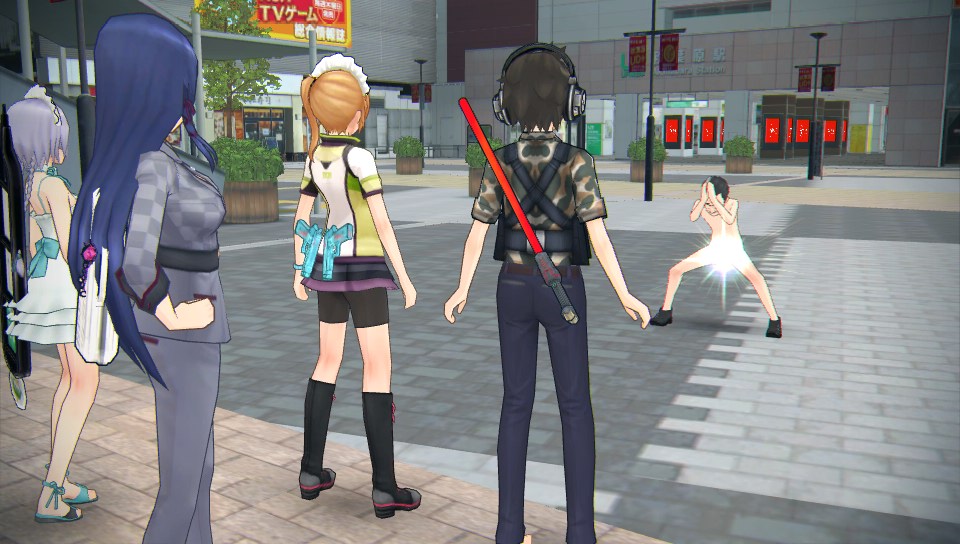
Akiba’s Trip is definitely a game for a niche audience, but I enjoyed it. It’s got fun and goofy gameplay, a pretty satisfying combat system, and loads of unlockables and extras (especially post-completion). It’s also not as pervy as you might think. I’m not particularly aiming to replay the game for its story and endings, but I know that I’ll be regularly revisiting the game for some brawls and collectibles.
For $40, you’re getting a pretty substantial and entertaining game. I’m crossing my fingers that it does well enough to warrant a sequel in the future, because who doesn’t want to collect the underwear of all of their enemies? … Is that weird?
 (7.5 / 10)
(7.5 / 10)
Good
 (7.5 / 10)
(7.5 / 10)
 cjmelendez_
cjmelendez_
